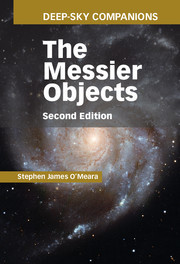Description
Deep-Sky Companions: The Messier Objects (2nd Ed.)
Author: O'Meara Stephen James
This updated Deep-Sky Companion features improved star charts for finding every Messier Object and a complete history of their discovery.
Language: English
Subject for Deep-Sky Companions: The Messier Objects:
Approximative price 50.13 €
In Print (Delivery period: 14 days).
Add to cart
Publication date: 04-2014
422 p. · 18.4x26.1 cm · Hardback
422 p. · 18.4x26.1 cm · Hardback
Description
/li>Contents
/li>Biography
/li>
The bright galaxies, star clusters, and nebulae catalogued in the late 1700s by the famous comet hunter Charles Messier are still the most widely observed celestial wonders in the sky. The second edition of Stephen James O'Meara's acclaimed observing guide to the Messier Objects features improved star charts for helping you find the objects, a much more robust telling of the history behind their discovery - including a glimpse into Messier's fascinating life - and updated astrophysical facts to put it all into context. These additions, along with new photos taken with the most advanced amateur telescopes, bring O'Meara's first edition more than a decade into the twenty-first century. Expand your universe and test your viewing skills with this truly modern Messier guide. It is a must for all budding night watchers.
Preface to the first edition; Preface to the second edition; Acknowledgments to the first edition; 1. A glimpse into the life of Charles Messier; 2. How to observe the Messier objects; 3. The making of this book; 4. The Messier objects; 5. Some thoughts on Charles Messier; 6. Twenty spectacular non-Messier objects; Appendix a: objects Messier could not find; Appendix b: why didn't Messier include the Double Cluster in his catalogue? Appendix c: a quick guide to navigating the Coma–Virgo cluster; Appendix d: Messier marathons; Appendix e: alternate name and object index; Image credits; Index.
Author of several highly acclaimed books, including others in the celebrated Deep-Sky Companions series, Stephen James O'Meara is well known among the astronomical community for his engaging and informative writing style and for his remarkable skills as a visual observer. O'Meara spent much of his early career on the editorial staff of Sky and Telescope before joining Astronomy magazine as its Secret Sky columnist and a contributing editor. An award-winning visual observer, he was the first person to sight Halley's Comet on its return in 1985 and the first to determine visually the rotation period of Uranus. One of his most distinguished feats was the visual detection of the mysterious spokes in Saturn's B-ring before spacecraft imaged them. Among his achievements, O'Meara has received the prestigious Lone Stargazer Award, the Omega Centauri Award and the Caroline Herschel Award. Asteroid 3637 was named O'Meara in his honor by the International Astronomical Union. In his spare time, he travels the world to document volcanic eruptions. He is a contract videographer for National Geographic Digital Motion and a contract photographer for the National Geographic Image Collection.
© 2024 LAVOISIER S.A.S.
These books may interest you

Herschel 400 Observing Guide 58.62 €



